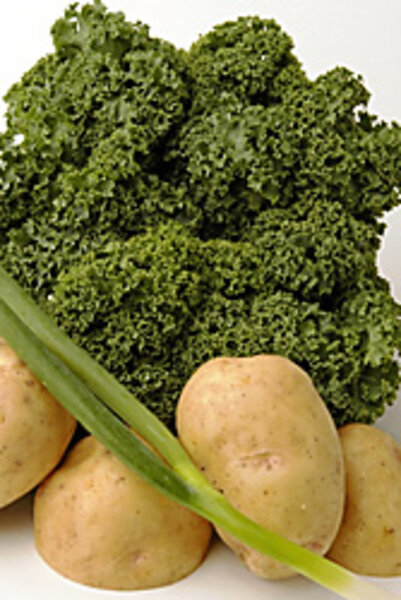Green potatoes? Must be St. Patrick's Day.
My younger daughter was born one day shy of St. Patrick's Day. We named her Kate for her Great-Aunt Kitty because we loved the name, not because she was Irish. I didn't understand then that a strong ancestral link could be forged with a country across the sea. My family hails from a part of the country that when asked, "Where did your people come from?," the answer is probably Virginia or South Carolina. Our connections are more local than global.
Then I moved to the North, to a street filled with Maloneys and Callahans who named their children Meghan and Timmy, Margaret Mary, and Patrick. And I learned a thing or two about being Irish.
I learned I'd better wear green on St. Patrick's Day or risk being pinched by a leprechaun. I learned to have at least a passing familiarity with the lyrics to "Danny Boy." I learned to identify the green, white, and orange of my neighbor's flag of Ireland.
And those things I call biscuits? The ones my family slathered with butter or honey, served with fried chicken, and passed piping hot around the Sunday dinner table? The Irish throw in currants or plumped-up raisins, serve them with clotted cream and homemade preserves, and call them scones.
My friend Edel is a transplanted Dubliner, a gourmet cook, and a terrific hostess. When she invites her girlfriends for a chin-wag and a spot of tea, I know that along with lively conversation, I'll sample the most delicious scones ever to pop out of an oven.
Last March, when she visited me in Florida, she agreed to prepare St. Patrick's Day dinner. The menu featured her mother's colcannon, a dish made with potatoes and kale. But kale proved elusive.
At the sixth Publix super–market we visited, we found a helpful produce man. "Do you have any kale?" we asked after a search turned up nothing. It was the wrong time of year, he had just sold the last bag, and it wasn't a highly requested item in our area.
But he offered to check the new deliveries. With great hope, we waited. When he returned with a big smile and a huge package of the dark-green leafy stuff, we took the kale triumphantly home. And although my friend claims colcannon is everyday food in her mom's kitchen, the dish was the hit of the meal.
This year, on March 17, many of the 35.9 million Irish-Americans living in the United States will be cooking corned beef and cabbage, soda bread, or boxty (a potato pancake).
I may not be able to dig deep enough to prove I'm Irish, Scottish, or a mixed-up conglomerate of all those vagabonds who migrated from the Old World to Virginia or South Carolina. But I'll tie my green shamrock scarf around my neck and bake scones for the neighbors. Then, if I'm fortunate enough to find a few bags of kale in my grocery store's produce aisle, I may even attempt colcannon.
My friend Jim Maloney claims that anyone with a daughter named Kate born minutes from St. Patrick's Day must have a wee bit o' the Irish in her. Besides, Jim tells me with a twinkle in his blue eyes, "On St. Patrick's Day, everyone's Irish!"
Irish Colcannon
2 pounds potatoes, peeled and quartered (Yukon Gold work well)
1 pound (about 4 cups) kale, washed, stemmed, and chopped
1 cup half-and-half or light cream
1 large bunch of green onions, chopped fine
5 tablespoons butter, melted
1 teaspoon salt
Pepper to taste
In a large pan, cook the potatoes in boiling water until tender. Drain thoroughly.
While the potatoes are cooking, cook the kale in a separate pan of boiling water until very tender. Drain thoroughly.
In a small saucepan, simmer the green onions in the cream just until tender.
Mash the potatoes well. Add cream and onions. Mix in kale, salt, and pepper.
Mound potatoes in a large bowl. Using a spoon, make a well in the top of the potatoes. Pour the melted butter into the well. Serve hot.
Makes 8 to 10 servings.





